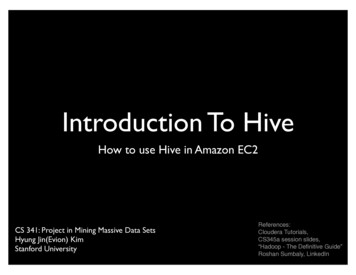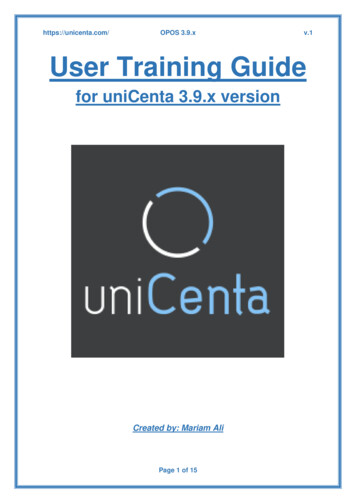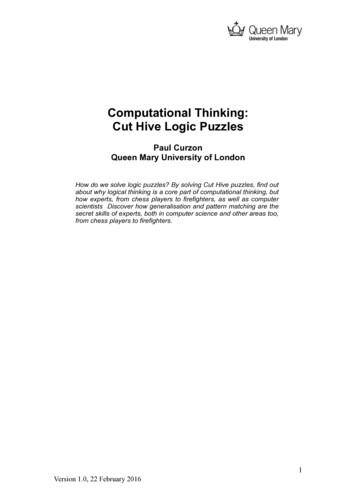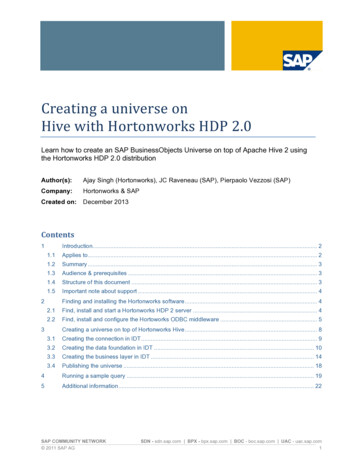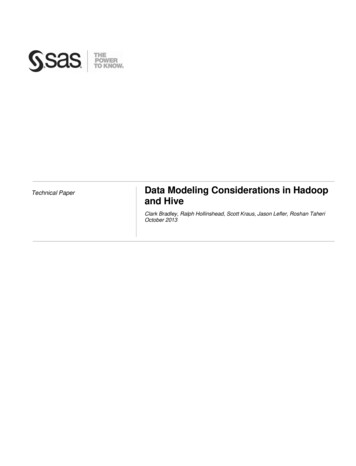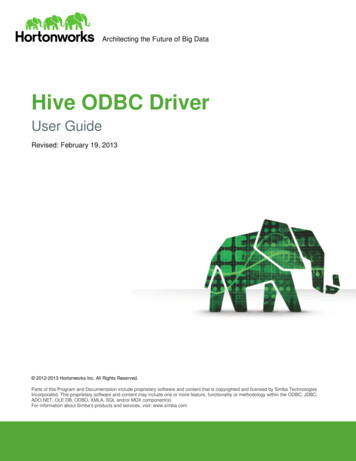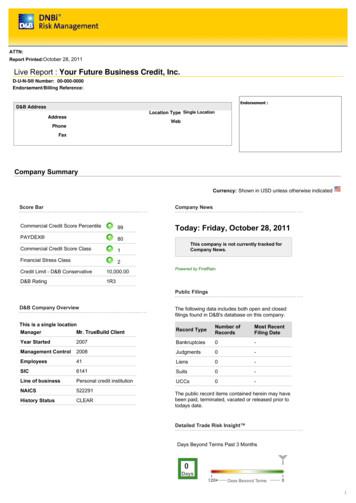
Transcription
THE RETAIL HIVE LIVE C r a c k i n g I n t e r n a t i o n a l M a r k e t sTHE RETAIL HIVE LIVEC ra c k i n g I n t e r n a t i o n a l M a r ke t sSkyloft, LondonJuly 2018
THE RETAIL HIVE LIVE C r a c k i n g I n t e r n a t i o n a l M a r k e t sA summary of the day.Our second annual Retail Hive Live – Cracking International Markets,was our biggest yet; welcoming over 80 senior retailers from acrossfashion, grocery, travel, homeware and many more industries – bothpureplay and bricks & mortar.We opened with an insightful and inspiring presentation from ourChairman, Mark Batty – Country Director, Germany & Rest of Worldat Boden who suggested that, in general, there are two types ofapproach for cracking international markets - the Hunter or theFarmer approach.We learned that, for retailers today, going international is not anoptional extra. We learned that, when it comes to entering newmarkets, it is not as simple as carbon-copying your home marketapproach. As a retail brand, you should have a dedicated internationalteam with a clear, diversified strategy for each market; spreadingyour risk to grow your brand. Furthermore, if your home market isstruggling, it will be difficult to be strong internationally. So a key tip isto make sure your ducks are in a row at home before you think aboutbuilding a presence in new markets!Thank you to our partners:From here we moved into our series of discussion groups covering criticaltopics including:1.2.3.4.5.6.7.8.Roadmap for LocalisationTailoring online Experience to Local CustomersFocus on Cross Border FulfilmentGlobal Customer Expectations on ReturnsGetting the Best out of MarketplacesFocus on USAFocus on ChinaFocus on GermanyWe’d like to thank everyone for their energy and contribution to this meetingand look forward to seeing you again at future Retail Hive meetings.With thanks,Noj Mather and Sally GreenCo-Founders - The Hive Network
THE RETAIL HIVE LIVE C r a c k i n g I n t e r n a t i o n a l M a r k e t s1R OA D M A P F O R LO C A L I S AT I O NTranslations.comDiscussion Summary:Examine website traffic and salesAre you seeing traffic, sales or even a high drop-off rate coming fromspecific markets? Do you see this drop-off rate specifically at high-riskelements, such as checkout? Potentially focus on these countries.What to do first?Translation, Payments, Returns etc. What to focus on first changescompletely from market to market. Some markets like Germany are bestdone all at the same time as they will see a similar uplift.MarketplacesUsing marketplaces like Tmall and Amazon offer an easier entry point intospecific regions as you may not need to deal with the fulfilment, localisationand payment challenges while they can help you build up an in-marketbrand presence.In China, marketplaces account for 90% of all eCommerce transactions andalready benefit from the huge in-country traffic. This is not always a longterm solution since a marketplace may cannibalise sales from your sites.“A great day to meet with otherretailers to discuss ideas and anyissues confidentially and in a positiveenvironment.Lulu Guinness“Know your value propositionBefore you dive into the world of cross-border eCommerce, you need toclearly understand why someone would buy from your brand internationally.What do you offer that established local competition doesn’t?
THE RETAIL HIVE LIVE C r a c k i n g I n t e r n a t i o n a l M a r k e t sR OA D M A P F O R LO C A L I S AT I O NTranslations.comTop 10 Takeaways:1. It is important to understand the tipping point for separate websitesvs. dynamic localisation of your core site.2. Each market needs individual consideration. i.e. the German marketis security conscious and will need sufficient security reassurancebefore purchase. Factors such as culture, language and preferencesshould be considered.3. Localisation is more than just translating your site. You needto understand your market and their behaviours. Knowing thedemographics of your customer can help you to understand if it’sworth paying to translate or not.4. It is important to understand brand values to set the right tone fortranslations. Having a clear value proposition that reflects brand DNAwill be beneficial. Without brand awareness growth will be slow.5. Be aware of differences in length of translated text. i.e. the Germanlanguage is around 35% longer than English and can cause problems.Arabic runs from right to left.6. Testing localisation does not have to be in your biggest growthmarket. Testing translation can be done through local PR teams.7. Weigh up the importance of implementing local payment methodsand fulfilment vs. full site localisation vs all of these at once.8. Across the board, traffic increases as a result of translations.9. The moment you translate your site, you set the customerexpectation that you can meet local service levels.10. Don’t forget bad debt expenses when preparing a business case.“The Hive Network puts like-mindedpeople in a room and enables honestconversation around retail/ecomevolution on an international scale.MOO“1
THE RETAIL HIVE LIVE C r a c k i n g I n t e r n a t i o n a l M a r k e t s2TA I LO R I N G O N L I N E E X P E R I E N C E T O LO C A L C U S T O M E R SBrightcoveDiscussion Summary:Translating content is not enough. Successful localisation requires adetailed and tailored strategy for each individual market.Firstly, the basic hygiene factors need to be in place – think aboutunderstanding local language and nuances to create the right tone ofvoice for your market, local currency preferences, payment and deliveryoption. Secondly, delivering relevant products and content specifically forthat market or region is of critical importance – advertising winter coats inAustralia in November, which is their summer, will get you nowhere.Having a dedicated team for each international market is critical. Somebrands create a separate team with local experience, whether employedcentrally or ‘in market’, whilst others work with local partners and agencies.Both options come with challenges and bring additional costs. Thesecould be offset by leveraging advanced machine-learning technologieswhich capture and record local behaviour to take away heavy lifting frommerchandising teams.If you engage with a local partner to leverage scale, it is essential to haveyour brand proposition in place prior to entering a new market so you haveclear rules and guidelines around your brand, ensuring it remains consistentacross all markets, assuming there is no cultural conflict which may requireflexibility of your brand.
THE RETAIL HIVE LIVE C r a c k i n g I n t e r n a t i o n a l M a r k e t sTA I LO R I N G O N L I N E E X P E R I E N C E T O LO C A L C U S T O M E R SBrightcoveTop 10 Takeaways:1. Focus on fulfilment first and translations later.2. Make use of a cultural gap analysis to understand the degree oflocalisation and possible barriers to entry.3. Think global! Play Local! If your brand strategy requiresdomestic market education – keep it simple.4. Localising is key in order to be successful in new markets.Cost of localising vs. benefit—how far do you go? Jugglingauthenticity while maintaining your brand identity.5. Understand your content drivers - focus on local content onceyou’ve removed the other barriers. See what content works:quality or quantity. Images/videos are more important thanthe words.6. Analyse the funnel by market and look where and howcustomers shop.7. It’s not good enough to have direct translation i.e. Germanshoppers like more details on products. Understanding localnuances is integral to successful localisation.8. Get your feet on the ground- visit the market to understand it.Having local teams/agencies for advice on the ground is key tounderstanding the market/focus group culture.9. Growth percentages are not the same everywhere. Dominantchannels influence international strategy.10. Lean on partners, distribution teams and local PR teams to findout what works in each market; but be aware that finding theright influencer is not easy.“This is my second event with The Hive,and cannot recommend it enough!The wide variety of attendees providesfor wide ranging insights, lessonslearnt and tips that is unlike any otherevent. The now ‘must do’ event in mycalendar is the next Hive day!Scribbler“2
THE RETAIL HIVE LIVE C r a c k i n g I n t e r n a t i o n a l M a r k e t s3FOCUS ON CROSS BORDER FULFILMENTAramex Global SolutionsDiscussion Summary:Over the 4 roundtables, there was a large variety of retailers, all wanting to discusstheir common and own challenges. It was a very open discussion on “do’s”, “don’ts” andpast experiences from e-tailers leading international eCommerce. We talked a lot aboutlocalisation versus going global, investing (or not) in local DCs and trying to find theright balance between “cost” versus “service proposition”.By getting more control and visibility on the journey and solving the customsclearance challenge, as a British retailer, you can offer a frictionless experience for yourinternational customers. Free shipping / free returns can work well but considerationshould be taken on a case by case basis – it does not need to be free-for-all: it shouldvery much depend on the product type, market and retailer size. Some retailers areprepared to try new options and new markets - even if it means failing to start with.The key to success is to keep the focus on a small number of specific markets at theoutset. In each of these markets it is integral to understand local trends and yourlocal customer target, and localise your fulfilment proposition and delivery promiseaccordingly. Other markets could be considered on a more opportunistic approachdepending on your .com traffic analysis.China is a market that needs significant research. Having a local partner to grow theChinese consumer demand is key to success.One last interesting point discussed was around collaboration on fulfilment; sharinglocal fulfilment capabilities between retailers.
THE RETAIL HIVE LIVE C r a c k i n g I n t e r n a t i o n a l M a r k e t sFOCUS ON CROSS BORDER FULFILMENTAramex Global SolutionsTop 10 Takeaways:1. Study the market before going there; markets have differentpreferences i.e. home delivery vs. collection.2. Partner with the right suppliers, look for expertise and find agreat partner.3. Free shipping is important to international customers.Offer free global shipping as a test for markets.4. Split shipments which do not affect UX can work!5. UK postal options are more established than manyEuropeans options.6. The Netherlands is well positioned for DC locations.7. China’s EMS tracking service is well built for optimisingsavings and removes complexity of commercial shipments.Duties are only payable if parcels are stopped. Only around 5%of parcels get stopped and checked.8. Fulfilment in the US is complex.9. Labour in Belgium is expensive.10. Refunding in 2 days supports repeated purchases andimproves customer retention.“Great content, awesome location,engaged participants and welllooked after - thank you, Hive!notonthehighstreet.com“3
THE RETAIL HIVE LIVE C r a c k i n g I n t e r n a t i o n a l M a r k e t sG LO B A L C U S TO M E R E X P E C TAT I O N S O N R E T U R N SReboundDiscussion Summary:There was a lot of diversity across the roundtables in terms ofretailer profile but there were some common attributes too.There was a big difference in returns rate across differentindustries i.e. less than 5% from perfume brands, rising to 35%plus for fast fashion. Product values also ranged from 5,000for a handbag, to 30 for trainers.However, a common theme was a need to integrate the rest ofthe business with returns and build some solid data to supportthe business case for international expansion.Additionally, all have aspirations to build a cross border returnscapability whilst very few have any experience on which to basefuture decisions.A crucial tip from the day’s discussions - Speed up the refund,but slow down the logistics.“Talk a little, listen more and learnloads! You can save your businesstime and money by absorbing andacting on the experiences shared inThe Hive events.Nourish London“4
THE RETAIL HIVE LIVE C r a c k i n g I n t e r n a t i o n a l M a r k e t sG LO B A L C U S TO M E R E X P E C TAT I O N S O N R E T U R N SReboundTop 10 Takeaways:1. The returns route map is by no means finalised. Many businesses havea fragmented returns strategy.2. Should returns be free? It is important to know your customer andhave a localised returns policy.3. Make use of customer insights generated through customer surveys.What are your customers’ expectations around returns?4. A lot of work is being done before the sale to try and minimisereturns. Ensuring the quality of products and dispatch procedures tominimise damage to shipments will reduce returns rate.5. Customers want a quicker and easier solution to returning productsespecially when it comes to refunds. But what about exchanges andspare parts? How to ensure customer satisfaction - customers don’talways want a refund!6. Including a return form in the parcel means that you have to rely oncustomer responses. People don’t mind going online for a return andit gives you the opportunity to encourage re-purchases – use links,ads and promotions.7. Don’t be concerned about high return rates; be concerned aboutgetting a better returns process! Look at how many customers whoreturn rebuy!8. Returns are seen as a barrier to cross-border. The high level of returnsin Germany is 50-70% across all industries (see Focus on Germany!).9. What do returns tell you about your business? Benefits of a highreturn rate? What is the true cost of returns?10. Sometimes there is no other choice than to abandon stockinternationally – even for luxury brands!“Great event, good networkingopportunities and veryinteresting topics!AllSaints“4
THE RETAIL HIVE LIVE C r a c k i n g I n t e r n a t i o n a l M
Tailoring online Experience to Local Customers 3. Focus on Cross Border Fulfilment 4. Global Customer Expectations on Returns 5. Getting the Best out of Marketplaces 6. Focus on USA 7. Focus on China 8. Focus on Germany We’d like to thank everyone for their energy and contribution to this meeting and look forward to seeing you again at future Retail Hive meetings. With thanks, Noj Mather and .
